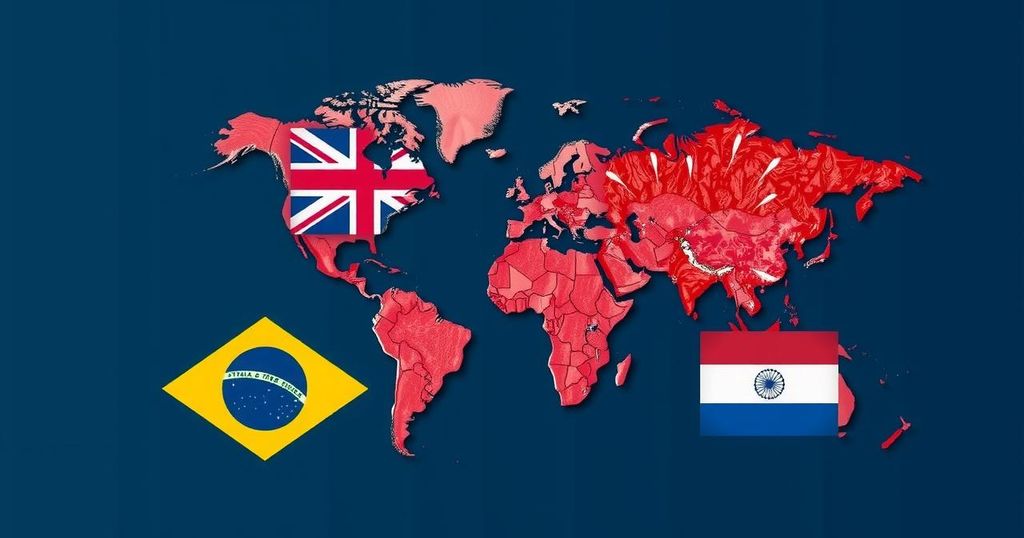The US expects a substantial 50% increase in beef imports from Australia, Brazil, and Uruguay in 2024, driven by high demand and favorable trade conditions. Experts express concerns over how these imports might impact domestic cattle prices and the viability of local ranching, emphasizing the need for a balanced approach to trade that protects American producers.
The United States is projected to significantly increase its beef imports from Australia, Brazil, and Uruguay in 2024, with estimates indicating a rise of at least 50 percent compared to 2023. Data from the United States Department of Agriculture (USDA) forecasts that imports from Australia will increase by 64 percent, Brazil by 50 percent, and Uruguay by 57 percent, according to Altin Kalo, an analyst affiliated with the Chicago Mercantile Exchange group. The predominant type of beef being imported is referred to as “lean grind” or “grinding beef,” typically arriving in a frozen state. This marks the highest volume of imports from Australia observed in the last decade. Eric Nelson, a cattle feeder from Iowa and a director at R-CALF USA, opines that the increase in beef imports has a direct impact on the pricing of American cattle. He noted, “They import ‘grinding beef,’ and that goes tit for tat against the value of cull cows here in the US. For people whose income solely comes from cattle, they get paid twice a year – once for their calves and once for their cull cows. The price of those cull cows is important.” Kalo highlighted that burger chains commonly source this imported beef, and the enhanced volumes stem from various market conditions. Furthermore, Nelson points out that the current demand for fat in slaughter cattle is indicative of escalating imports. He draws parallels to the cattle dynamics of 2015, a year marked by high imports as well. The contrasting cattle cycles between the United States and Australia also elucidate this phenomenon. Kalo clarified that while the US is seeing a depletion in its cattle stock, Australia has been rebuilding its herd, currently at a cyclical peak. He noted, “We (in the US) are paying the highest prices for lean beef that we ever have, that makes Australian beef more attractive. That is how markets function, the product goes to where the demand is.” The absence of tariffs on Australian beef due to a Free Trade Agreement facilitates these imports. However, Kalo remarked on the fluctuating global demand as influenced by China, which has recently stabilized its beef import requirements. Previously, the demand from China would have directed more beef to its markets, but now it shows a preference for supplying the US. In contrast, imports from Brazil are subject to tariffs since there is no Free Trade Agreement in place, yet companies are still willing to absorb these costs due to significant price pressures within the US market. Kalo asserted that without the imports, domestic costs would rise, potentially resulting in higher prices for consumers, who may then seek alternative protein sources. Nelson cautioned that the reliance on imports bears risk for the American cattle industry. He stated, “It’s death by a thousand cuts. They tell us they have to keep importing, but once we lose a vibrant industry like the cattle industry – and the sheep industry – the corporations will take over.” He emphasized a possible decline in consumer welfare should corporations dominate the food supply. Additionally, the report notes that feeder cattle imports from Mexico have surged, with an increase of 32 percent recorded compared to the previous year. The USDA predicts that Mexican cattle exports to the US will reach 1.45 million head in 2024. The implications of this trend indicate that Mexican calves, while not a direct substitute for feeder calves from Northern states, still influence price dynamics within the industry. In summary, while some industry experts assert that trade offers various benefits, there is a strong caution against over-reliance on foreign imports, which may threaten domestic production and rural economies.
This article discusses the anticipated rise in beef imports to the United States from Australia, Brazil, and Uruguay in 2024. It incorporates insights from industry analysts and stakeholders who explore the implications of these imports on domestic cattle prices, the impacts of international trade agreements, and the evolving dynamics of the global beef market, particularly in light of China’s demand shifts and the contrasting cattle cycles between countries. The article serves to inform readers about the complexities and competitive pressures affecting the US cattle industry, amidst rising import trends.
The projected increase in beef imports from Australia, Brazil, and Uruguay highlights significant shifts in the US beef market dynamics for 2024. With escalating prices for lean beef, American consumers may increasingly rely on imported products, raising concerns about the long-term sustainability of domestic cattle operations. Industry experts like Kalo and Nelson stress the importance of stabilizing domestic production to avert potential monopolization by corporate entities. As market conditions evolve, the implications for ranchers and consumers alike warrant careful scrutiny.
Original Source: www.tsln.com






